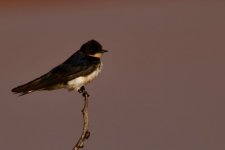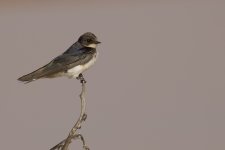-
Welcome to BirdForum, the internet's largest birding community with thousands of members from all over the world. The forums are dedicated to wild birds, birding, binoculars and equipment and all that goes with it.
Please register for an account to take part in the discussions in the forum, post your pictures in the gallery and more.
You are using an out of date browser. It may not display this or other websites correctly.
You should upgrade or use an alternative browser.
You should upgrade or use an alternative browser.
Is this a juvenile Barn Swallow? At Hesaraghatta Lake, Bangalore, India (1 Viewer)
- Thread starter rsriram9
- Start date
More options
Who Replied?Alexander Stöhr
Well-known member
Not a definitive answer, but one to alert others so I can learn.
This bird doesnt look like a Barn Swallow, that I see in Europe:
Yes, I am extremly critical with colours here, and ignoring that colours might not represent the real one of this bird, but they result in a strange feeling of this bird
Conclusion? I haven experience with Swallows in Asia, so I dont know, what it is. But as said, this bird doesnt look like a "European Barn Swallow".
This bird doesnt look like a Barn Swallow, that I see in Europe:
- unusual shape of bill (and slightly to small in relation to head, allthough raised head feathers makes head look bigger)
- Green sheen to some wing feathers is out of variation for this (is this a result of picture manipulation to achieve a better looking picture, no offense)
- buffish-cream on forehead is also wrong for a European Barn Swallow
- exakt brown shade to head is very unusual for this, too
- the exact shape of the dark hood is unusual/some kind of strange to me
- the pale area of the forehead is not extensive enough, even for the majority of juvenile Barn Swallows (it reaches towards eye in most)
- I get the feeling that the dark breast patches or a breast band should be visible here, allthough it seems to be a bad position to judge this.
Yes, I am extremly critical with colours here, and ignoring that colours might not represent the real one of this bird, but they result in a strange feeling of this bird
Conclusion? I haven experience with Swallows in Asia, so I dont know, what it is. But as said, this bird doesnt look like a "European Barn Swallow".
Deb Burhinus
Used to be well known! 😎

Looks ok for a juvenile Hirundo rustica to me - there are regional/clinal variations and various sub-species recognised across the region but I wouldn’t know how to separate them or what the ranges/overlap of each is!
iridescent blue can often look green.
Not sure if that’s any help 😙
iridescent blue can often look green.
Not sure if that’s any help 😙
Alexander Stöhr
Well-known member
Hello,
thank you for the new picture and Deb for your interesting comment and pictures!
In the new picture with better resultion, it is clear, that the pale area on forehead reaches to the eye, and the loral area is slightly darker than crown and ear-coverts (resulting in a triangular loral area). This, together with a slightly down-curved bill and a angry-looking gape-line results in a better looking head for a Barn Swallow than the first picture (who told me, that its often not good to squeeze too much out of picture? It was you, Deb and others. Thanks again!)
And with the pictures, it seems that I have never seen such a faded Barn Swallow, resulting (?) in brown tones/hues and clear whitish/whitish-cream feathers to the throat (I cant remember seeing a Barn Swallow in winter, therefore I havent seen such a Barn Swallow). Or can Barn Swallows from India so different from those in Europe? Because I cant remember having seen a European Barn Swallow with green irescent colour like this (Yes, iridescent blue can often look green, but I havent seen this in a Barn Swallow before).
thank you for the new picture and Deb for your interesting comment and pictures!
In the new picture with better resultion, it is clear, that the pale area on forehead reaches to the eye, and the loral area is slightly darker than crown and ear-coverts (resulting in a triangular loral area). This, together with a slightly down-curved bill and a angry-looking gape-line results in a better looking head for a Barn Swallow than the first picture (who told me, that its often not good to squeeze too much out of picture? It was you, Deb and others. Thanks again!)
And with the pictures, it seems that I have never seen such a faded Barn Swallow, resulting (?) in brown tones/hues and clear whitish/whitish-cream feathers to the throat (I cant remember seeing a Barn Swallow in winter, therefore I havent seen such a Barn Swallow). Or can Barn Swallows from India so different from those in Europe? Because I cant remember having seen a European Barn Swallow with green irescent colour like this (Yes, iridescent blue can often look green, but I havent seen this in a Barn Swallow before).
Alexander Stöhr
Well-known member
Hello Kite,
x-posted with you. You shouldnt lay much/anything in my first comment from yesterday. I have only experince with Barn Swallows in Europe, so I learned from others with more experience here.
The only thing that I cant resist: if the unusual/different appearance of this bird isnt the result of wear and bleaching, but from geographical variation/subspecies, than such a bird would attract attention when occuring in Europe and would be IDable as "showing characters of eastern forms" (hope thats understandable and correct) with a very high degree of certainty imo.
x-posted with you. You shouldnt lay much/anything in my first comment from yesterday. I have only experince with Barn Swallows in Europe, so I learned from others with more experience here.
The only thing that I cant resist: if the unusual/different appearance of this bird isnt the result of wear and bleaching, but from geographical variation/subspecies, than such a bird would attract attention when occuring in Europe and would be IDable as "showing characters of eastern forms" (hope thats understandable and correct) with a very high degree of certainty imo.

Yes, very much so. I have only been to Sri Lanka and the usual forms are gutturalis and tytleri . Tytleri has a red underside. I first thought I had a Sri Lanka Swallow, but it was a tytleri. I found the SLS later fortunately, as it is endemic. Sri Lanka is good for endemics, (34 species and 68 subspecies).The only thing that I cant resist: if the unusual/different appearance of this bird isnt the result of wear and bleaching, but from geographical variation/subspecies, than such a bird would attract attention when occuring in Europe and would be IDable as "showing characters of eastern forms" (hope thats understandable and correct) with a very high degree of certainty imo.
johnallcock
Well-known member
The colours on this bird (blackish-brown upperparts, pale throat, worn forehead) look fairly normal for a worn first-winter individual, which do look quite different from adults and fresh juveniles you will have seen in Europe. You can see the white patch in the tail consistent with ID as Barn Swallow.Hello Kite,
x-posted with you. You shouldnt lay much/anything in my first comment from yesterday. I have only experince with Barn Swallows in Europe, so I learned from others with more experience here.
The only thing that I cant resist: if the unusual/different appearance of this bird isnt the result of wear and bleaching, but from geographical variation/subspecies, than such a bird would attract attention when occuring in Europe and would be IDable as "showing characters of eastern forms" (hope thats understandable and correct) with a very high degree of certainty imo.
The feathers that appear to have some greenish gloss are very freshly replaced through moult. I think it's not too unusual for these to look similar to this (at least it is in Asian gutturalis, I don't know about European birds moulting in Africa). Such a bird will still look blue in the breeding season, similar to European birds.
I think the best feature to look for a vagrant Asian Barn Swallow in Europe may be the breast band, which tends to be broken and incomplete on Asian birds.
Deb Burhinus
Used to be well known! 😎

I agree.The colours on this bird (blackish-brown upperparts, pale throat, worn forehead) look fairly normal for a worn first-winter individual, which do look quite different from adults and fresh juveniles you will have seen in Europe.
It looks very much like the October/January links I posted above with retained juvenile flight feathers (faded and very brown) with some replaced coverts (and tertials?).
As previously mentioned, variations in ssp of Asian Barn Swallow are complex and not well resolved - yes, the nominate has a solid and wide black breast band in mature individuals and does occur in Western and Central Asia. The Asian Barn Swallow that John refers to, also occurs to the East of the Himalayas -> Japan afaik and has a narrower breast band in adults and rufous throat in imm. cf to a buff throat as in OP
There is another ssp of Asian Barn Swallow, tytleri which winters in Bengal has a dark rufous throat and underparts (which clearly the OP does not) http://orientalbirdimages.org/search.php?Bird_ID=1747&Bird_Image_ID=98597
but not sure how far West this occurs?
It would of course be helpful to know the date it was taken too.
Last edited:
Users who are viewing this thread
Total: 2 (members: 0, guests: 2)






